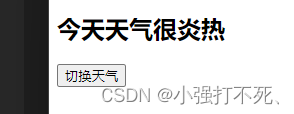1.通过一个点击切换的案例来理解


<div id="root">
<h2>今天天气很{{info}}</h2>
<button @click="changeWeather">切换天气</button>
<!--绑定事件的时候 @xxx=yyy yyy可以写一些简单的语句 -->
<!-- <button @click="isHot=!isHot">切换天气</button> -->
</div>
<script>
Vue.config.productionTip = false // 以阻止 vue 在启动时生成生产提示
new Vue({
el: '#root',
data: {
isHot: true
},
computed: {
info() {
return this.isHot ? '凉爽' : '炎热'
}
},
methods: {
changeWeather() {
this.isHot = !this.isHot
}
},
})
</script>?2.?监视属性watch:
? ? ? ? ? ?1.当被监视的属性变化时,回调函数自动调用,进行相关操作
? ? ? ? ? ?2.监视的属性必须存在,才能进行监视!!!!
? ? ? ? ? ?3.监视属性的两种写法:
? ? ? ? ? ? ? (1). new Vue时传入watch配置
? ? ? ? ? ? ? (2). 通过vm.$watch监视
watch: {
isHot: {
immediate: true, // 初始化时让handler调用一下
// handler什么时候调用?当isHot发生改变
handler(newValue, oldValue) {
console.log('isHot被修改了', newValue, oldValue);
}
}
}
vm.$watch('isHot', {
immediate: true, // 初始化时让handler调用一下
// handler什么时候调用?当isHot发生改变
handler(newValue, oldValue) {
console.log('isHot被修改了', newValue, oldValue);
}
})3.深度监视:
(1). Vue中的watch默认不检测对象内部值的改变(一层)
(2). 配置deep:true可以监测对象内部值改变 (多层)
?备注:
? ?(1). Vue自身可以检测对象内部值的改变,但Vue提供的watch不可以
? ? (2). 使用watch时根据数据具体结构,决定时候采用深度监视 ?
<div id="root">
<h2>今天天气很{{info}}</h2>
<button @click="changeWeather">切换天气</button>
<hr>
<h3>a的值是:{{number.a}}</h3>
<button @click="number.a++">点我让a+1</button>
<h3>b的值是:{{number.b}}</h3>
<button @click="number.b++">点我让b+1</button>
</div>
const vm = new Vue({
el: '#root',
data: {
isHot: true,
number: {
a: 1,
b: 1
}
},
computed: {
info() {
return this.isHot ? '凉爽' : '炎热'
}
},
methods: {
changeWeather() {
this.isHot = !this.isHot
}
},
watch: {
isHot: {
// immediate: true, // 初始化时让handler调用一下
// handler什么时候调用?当isHot发生改变
handler(newValue, oldValue) {
console.log('isHot被修改了', newValue, oldValue);
}
},
// 监视多级结构中某个属性的变化
// 'number.a': {
// handler() {
// console.log('a变了');
// }
// }
//监视多级结构中所有属性的变化
number: {
deep: true,
handler() {
console.log('number改变了');
}
}
}
})? ? ? ? ?